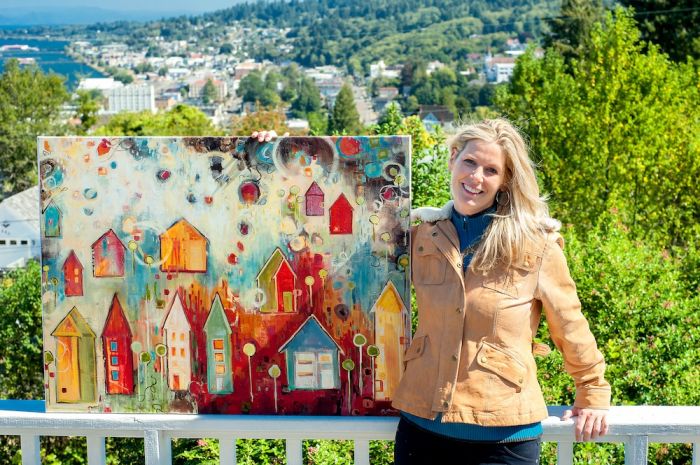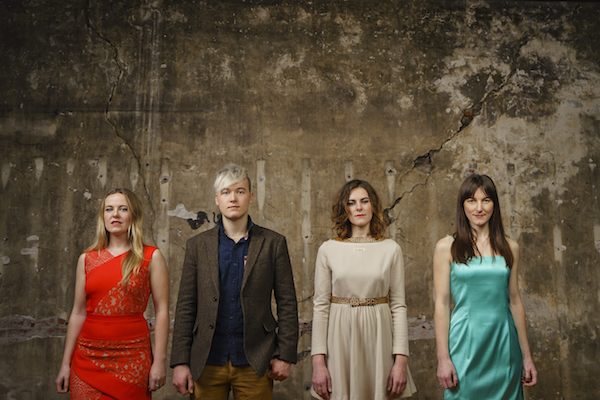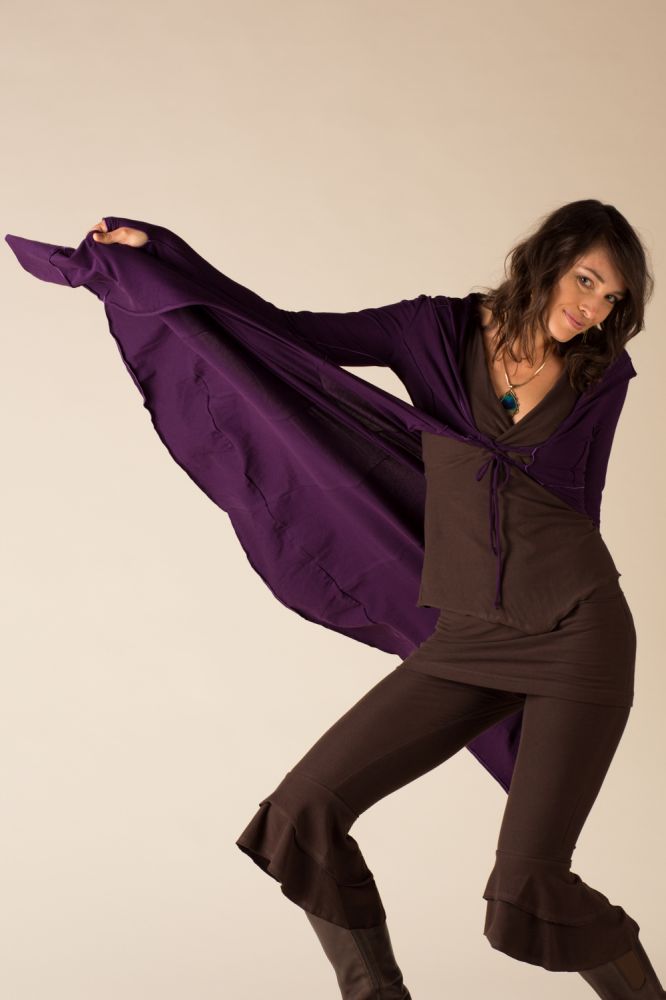A gallery of Goodnough’s work appears at the bottom of this article.
As the opening day deadline loomed for the new luxury Cannery Pier Hotel in Astoria, laborers and designers on the large-scale construction project were unable to synthesize the essence of the dream of owner-developer Robert Jacob. Into this chaos stepped the person who would become Jacob’s life partner, Sarah Goodnough. As she decided on room colors, number plates, lighting fixtures and furniture placement, Goodnough was laying the groundwork for her own lifelong ambition to become a professional artist.
While other details were being executed, art had somehow fallen between the cracks on the pier. Jacob, or “Jake” as he is known, asked Goodnough to fill the walls with her own art—scenes of bridges, fish and boats. That was the turning point for Goodnough’s incipient career. She hung her painting of a shoal of salmon swimming through pilings over the mantelpiece in the lobby and, soon after, someone bought it.
Seven years later, Goodnough was listed as one of the top fifty emerging artists of 2012 in Art Business News magazine. She has more work than she can handle. Featured at the Modern Villa gallery in Cannon Beach, her work sells regularly. Calls for commissions keep her busy, shuffling between her Portland and Astoria home studios where she divides her time. Today, she faces the difficult decisions that come with success—whether to hire an assistant, license her work or show in other galleries.
The head of success often has a long tail. Even though it began with an accidental commercial commission at the Cannery Pier Hotel, Goodnough’s path to success was arduous. She had always dabbled in drawing and art, and wanted to pursue it as a professional course. It was the advice of practical-minded people that kept her from committing. After a hopscotch through majors— zoology, psychology, geography— Goodnough got a degree in communications, specializing in video analog “just to get a degree in something!” By the time the college president handed Goodnough her diploma, her degree was already obsolete.
During college, Goodnough traveled west in the summers doing a variety of odd jobs and visiting many of the West’s iconic national parks and places. After a summer job in Yellowstone Park, she took the fall semester off and tramped through the Tetons, Crater Lake, Yosemite, King’s Canyon, Grand Canyon, Bryce Canyon and Zion.
“We grew up without a lot of money,” says Goodnough, “so I guess you could say I had that adventuring spirit.”
After graduating in 1995, she moved to Baltimore, Maryland, but the West continued to call to her. “I love the scenery— everything’s on a grand scale,” she says. Smitten, she moved to Oregon in 1997, staying with a college friend in Portland until she got settled. She took a variety of art courses from basic design to watercolor at Portland Community College. Finally she decided to just create art rather than pursue a degree. Still, there were bills to pay and a living to make. She left waiting tables and bartending for a career in tattooing because it seemed related to art and would give her flexible hours while she pursued painting.
“I kept thinking that I had to find a way to make more money so I could paint,” Goodnough recalls. “I just never thought I could make money with art.”
In 2003, she connected with Jake, an accomplished developer. She dropped her cosmetic tattooing business and stepped into the hotel project.
Jake introduced Goodnough to mentors in selfmotivation. She then pursued an intense study of the masters on her own—Monet, Chagall and Peter Max. Eventually, she found her own voice in art. “After submerging myself in studying different artists and their art, I got to this point where I wanted to stop looking at other people’s art work,” she says, “I needed to stick to my own way of doing things so that it remained my own.”
Her style has dramatically changed from the bridges, fish and boats that launched her career to include ethereal landscapes that simultaneously evoke Monet impressionism and Max color. Some paintings are intensely personal, erupting out of painful experiences—most are depictions of harmony.
“We are surrounded by chaos and ‘busy-ness,’” Goodnough says. “Our personal places should be where we can escape it.”
The artist applied this philosophy to her studio in Astoria. The unfinished basement that seemed a perfect place for spilling paint and stacking canvases has metamorphosed into a comfortable living space that she and Jake can enjoy together with their golden retriever, Milo.
Goodnough works on several pieces at a time. Painting in layers, she begins with putting texture onto the canvas with a molding paste. Later, she adds a color wash to the canvas, which she says is the “fun part.” Then, starting with dark colors, she overlays them with progressively lighter colors until it’s time to paint trees, birds, terrain or structures. She completes the painting with a lot of glazing.
Goodnough paints using an internal vision as her guiding principle. She does, however, occasionally reference inspiration—an untidy pile of variedshaped clippings. As she continues to mature as an artist, the human figure is on her mind—an artistic challenge she has not yet attempted. “There are things I want to say through the figure,” she says. “I want a whole new way of speaking.”
She wants to experiment and avert the trap of becoming too closely associated with a certain style or subject in her art.
In her studio, an unfinished painting of a blossoming tree leans against the wall. Goodnough began it after a dog of hers died. On an easel sits a painting in its embryonic stage, just a wash of color. Next to that is a nearly-finished piece with hummingbirds fluttering around the branches of a tree.
Goodnough recalls a time when she was 30 and still hadn’t really “done anything.” She was a lost soul seeking an identity. Through her painting, Goodnough has found a quiet strength and a purpose. “I’m really thankful for all the years of struggling, because now I really enjoy where I am,” she says.
To see more of Goodnough’s work, visit sarahgoodnough.com









